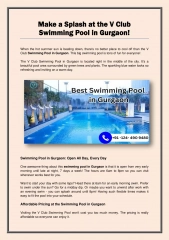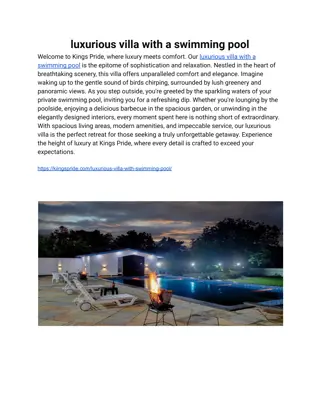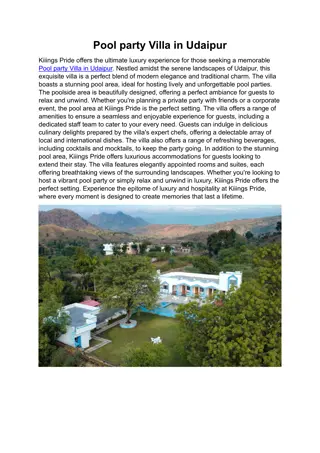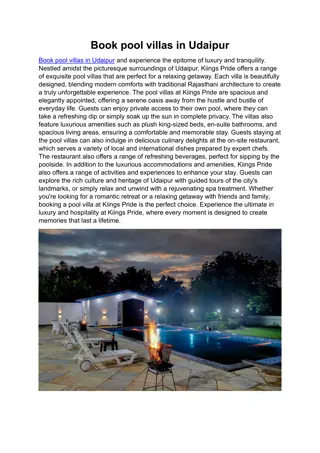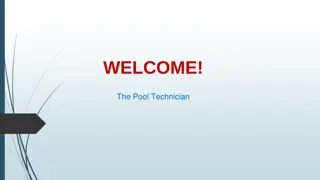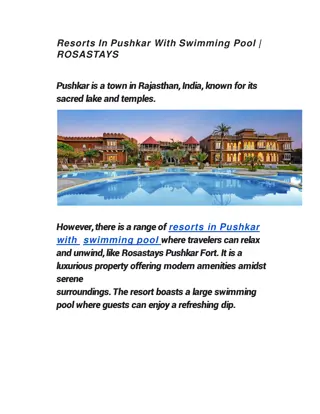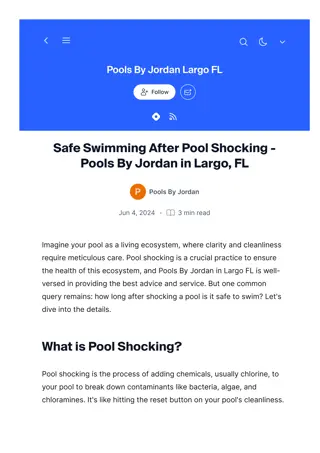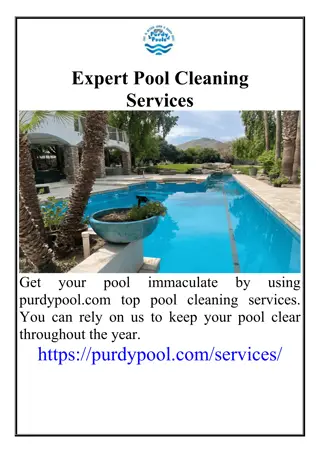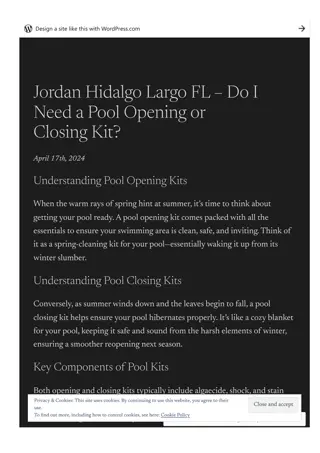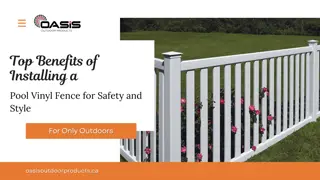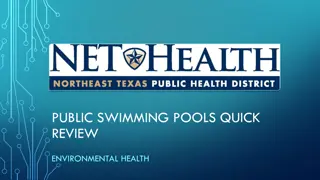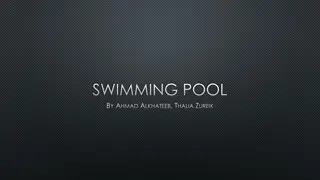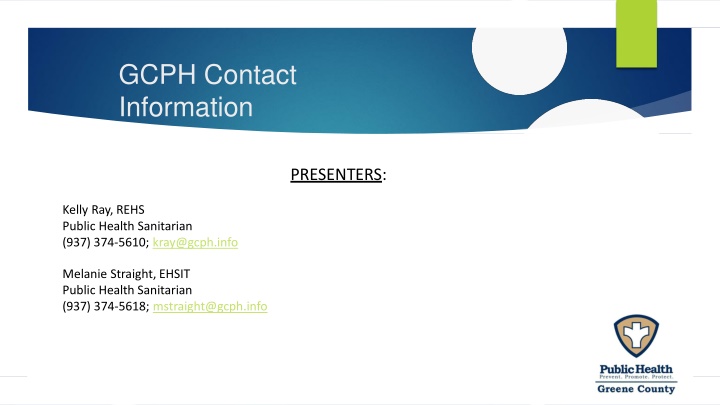
Pool and Spa Safety: Regulations, Health Concerns, and Illness Prevention
Learn about the regulations, health concerns, and illness prevention strategies concerning pool and spa safety. Discover how to protect public health, follow safety regulations, and prevent the spread of illnesses in aquatic facilities.
Download Presentation

Please find below an Image/Link to download the presentation.
The content on the website is provided AS IS for your information and personal use only. It may not be sold, licensed, or shared on other websites without obtaining consent from the author. If you encounter any issues during the download, it is possible that the publisher has removed the file from their server.
You are allowed to download the files provided on this website for personal or commercial use, subject to the condition that they are used lawfully. All files are the property of their respective owners.
The content on the website is provided AS IS for your information and personal use only. It may not be sold, licensed, or shared on other websites without obtaining consent from the author.
E N D
Presentation Transcript
GCPH Contact Information PRESENTERS: Kelly Ray, REHS Public Health Sanitarian (937) 374-5610; kray@gcph.info Melanie Straight, EHSIT Public Health Sanitarian (937) 374-5618; mstraight@gcph.info
Introduction to Pools and Spas Presented by:
Purpose of Pool & Spa Safety Protect the public from possible safety and healthhazards Provide a basic knowledge of regulations from the healthcode Build a good relationship between pool operators and the health department
Rules and Regulations Pool operators must be aware of many requirements to safely operate their pools. These requirements are important to the health and safety of the patrons, and all people who are in charge at the pool should be aware of the regulations. Greene County Public Health (GCPH) a local public health agency that regulates pools/spas Ohio Department of Health (ODH) a state public health agency that creates regulations and sets minimum standards within the state of Ohio. The Occupational Safety and Health Administration (OSHA) Protects the safety of workers The Center for Disease Control and Prevention (CDC) Does not regulate, but advises and investigates outbreaks of communicable disease Consumer Product Safety Commission (CPSC) protects the public from unsafe products. Example: VGB.
HealthConcerns It is possible to spread illness from person to person via pool or spa water E.Coli 0157:H7 Cryptosporidium Germ HepatitisA Giardia Common forms of these illnesses include: E. coli 0157:H7, Hepatitis A, Giardia, and Cryptosporidium (Crypto) Time Less than 1 minute About16 minutes About 45 minutes About 15,300 minutes or10.6 days Disinfecting and keeping proper water chemistry in the pool/spa will reduce the risk of these pathogens
How Are Illnesses Spread atAquatic Facilities? These illnesses are not only spread by blood - most can be spread: By swallowing contaminated water By accidentally swallowing something that has come in contact with thestool of a person or animal infected with thegerm By swallowing the germ picked up from surfaces (such as lounge chairs, picnic tables, bathroom fixtures, changing tables) contaminated with the stool from an infected person
How do I promote healthy swimming? Encourage swimmers TO: Practice good hygiene such as: taking a shower beforeswimming washing their hands after using the toilet changingdiapers Take children to the bathroom on breaks and change swim diapersoften Only change diapers in the bathroom Wash children thoroughly (especially the rear end) with soap and water before swimming
How do I promote health swimming? Encourage swimmers NOTTO: Swim when they have diarrhea Swallow the pool water Change diapers poolside
Testing the Water It is required that each licensed pool or spa havea diethyl-p- phenylediamine (DPD) test kit Read directions Store in a cool, darkplace Keep equipment clean Do not mix test kits Replace reagents yearly
Testing the Water Remember thesetips: Test pools at opening and at least once every 4 hours unless using an automatic chemical controller, in which case these must be manually tested every 12 hours Obtain sample away from inlets and outlets Ensure that the comparator tube is placed at least 18 inches below the surface (elbow deep) to ensure accuracy Test logs must be kept on file for at least 2 years Calibrate your thermometer regularly Ensure that all chemical treatments have completely dissolved and mixed prior to re-testing or allowing entry into the pool
Required Levels Pools: At least 1ppm Spas: At least 2ppm Free Chlorine Water Chemistry Required Levels Less than 1 ppm CombinedChlorine Pools: At least 2ppm Spas: At least 4ppm Bromine 7.2-7.8 pH Values At least 60ppm TotalAlkalinity Less than 70 ppm CyanuricAcid Pools: Not above 90 F Spas: Not above104 F Temperature
Water Quality & Disinfectant Types Salt Other types of Disinfectant The salt solution passes through an electrolytic which produces chlorine from the chloride ion in salt cell Sodium Hypochlorite (Liquid chlorine) Bromine Appropriate levels to maintain a proper chlorine level is about 2,500 to 4,000 ppm. TriChlor/DiChlor UltravioletLight This amount of salt is undetectable to bathers Ozone The cells also need to be routinely cleaned to ensure they are working properly Ionization Copper/Silver Calcium Hypychlorite
Water Quality & Disinfectant Types Chlorine Free Chlorine = available disinfectant Combined Chlorine (aka Chloramines) = result of free chlorine combining with organic compounds containing nitrogen (N) such as urine Total chlorine free chlorine = combinedchlorine Free chlorine: > 1ppm for pools and > 2 ppm for spas Combined chlorine is ideally ZERO.Too much can create the chlorine smell in indoorfacilities
Other Water BalanceFactors pH Temperature Temperature is a physical factor that contributes to water quality In pools, the water temperature should not be higher than 90 F In spas, the temperature should not be above 104 F At high temperatures, the disinfectant can quickly evaporate, or in the spa, scalding can occur
Operational Requirements Flow Draining Requirements Mixing/Holding Tank requirements These are often found atspray grounds The flow rate is the rateof water flow through the circulationsystem Spas must be completely drained at least once every30 days They must be cleaned and drained at least onceevery 120 days Draining is also necessary when water chemistry concentrations are off and no other chemical treatments are successful Flow rate is measured in gallons per minute(GPM) Must have a working flow meter at all times to ensure proper circulation of disinfectants/turn- overrates Cyanuric acid levels canonly be reduced bydraining If the float is stuck, trycleaning the flowmeter If minimum flow rate is not being achieved, cleanfilters
SVRSSystems Safety Vacuum Release System (SVRS) Safety Vacuum Release Systems are required on pools or spas with one main drain on direct suction This device senses a blockage on the drain and reduces or eliminates suction at the drain Should be mounted ahead of the hair and lint strainer in the equipment room or integrated with the pump
VGB VGB Main Drain Main drains are important to your pool s operation Main drains must be in the deepest area of the pool or spa Drains must be covered with VGB-compliant grates that require the use of tools for removal (be certain to verify manufacturer s expiration dates/check for recalls) Pools or spas on direct suction and no SVRS must have 2 drains a minimum of 3 feet apartunless the drain is considered un-blockable (greater than or equal to 18 inches x 23 inches) Main drains must be visible
Virginia Graeme Baker Requirements Entrapment hazards Hair Limbs Jewelry Disembowelment /evisceration
Virginia Graeme Baker Requirements Entrapment on main drain
Virginia Graeme Baker Requirements Unblockable draincovers Maindrains :Single drain:18 x23 :Two drains: minimum 3 between drains Equalizerlines Covers? Plugs? Other submergedoutlets
Virginia Graeme Baker Requirements VGB Compliant Outlet Covers (Equalizer lines) Plugs in sidewalls
Virginia Graeme Baker Requirements VGB Compliant DrainCovers
Virginia Graeme Baker Requirements Look for the ASMEsymbol embossed oncover
Virginia Graeme Baker Requirements Single MainDrains Single Main Drains Compliant covers :Licensee must keep written documentation on file Secondary means of entrapment prevention: Monthly tests results taken and recorded on Weekly report forms by licensee
Virginia Graeme Baker Requirements Multiple Drains Multiple DrainCovers VGB Compliant covers Minimum Distance Between Drains
Virginia Graeme Baker Requirements And, yes, you may indeed need toverify the compliance of those drain covers!
Virginia Graeme Baker Requirements Stingl(SVRS)
Virginia Graeme Baker Requirements Vac-Alert(SVRS)
Virginia Graeme Baker Requirements Stratum(VRS)
EquipmentMaintenance It can be easy to neglect the equipment room, because it is hidden from the view of the public. However, it is important to ensure that this room is: Clean and well-drained Damaged walls, etc. are repaired Adequately lit and ventilated,and Not accessible to bathers and patrons Ensure that skimmers are cleaned regularly The disinfection system must be maintained The automatic chemical controller probes must be calibrated and maintained Hand dosing to continuously disinfect the pool is unacceptable!
FacilitySafety Mandatory Fencing Guidelines All fences must be at least 48 inches high measured from the ground (wading pools must have a fence at least 36 inches high) All perimeter fences or barriers must not have any opening that will allow a sphere with a diameter of 4 inches to pass through All doors or gates must be self-closing, self-latching, lockable (require a key for entry) and the latch must be at least 38 inches from the ground All barriers must be locked whenever the pool is closed
FacilitySafety Safety Checklist Spineboard (headgear on guardedpools) Working emergency telephone w/instructions (example: dial 9) and emergencynumbers First Aid supplies (bandages, gauze, disposable gloves, etc.) cannot be in a locked room! Self-closing gates Ring Buoy and rope, non-telescoping reachpole Shepherds crook if no lifeguard Ladders and diving boards aresecure Verify that underwater lightswork Starting blocks inaccessible
RequiredSignage No Diving for depths< 5 feet Depth Markers (at least 4 inches high) If no lifeguard: Warning, No Lifeguard Swimming alone is notrecommended Children must be supervised Anytime the pool or spa is closed, you must post at least one sign stating Danger Pool (or Spa) Closed or Warning Pool (or Spa)Closed
Signage for Spray Grounds Using same or similar language as listedbelow: Do not use pool while having diarrhea Water is not to be swallowed Wash hands after using the restroom or changing diapers Take regular restroom breaks or change diapers only in a restroom Manufacturer s safety recommendations must be posted conspicuously
Signage for Slides Safety recommendations must be posted conspicuously at theslide Only one user at a time, nochains Check to see that landing areas are clear before entering theslide Users must exit the landing areaimmediately Feet first Minimum user height must beposted Life jackets or other flotation devices are prohibited other thanthose designed for the slide and used as directed by themanufacturer
Lifeguards When are lifeguards required? All pools with diving boards All pools with recreational slides All pools with surface areas of 2,000 square feet or greater All pools with a surface area of less than 2,000 square feet and more than 50 people occupying the pool All pools with zero depth entry with depths more than 18 inches Public swimming pools that are 6,000 square feet or larger must have a written plan that shows adequate lifeguard coverage.
Lifeguards Lifeguards must Be capable swimmers Have a clear and unobstructed view of the pool bottom and areas under supervision Hold a current valid certification as alifeguard Be certified in CPR and First Aid (pool operator must maintain copies of certifications) Be prepared to enter the water at any time Have a rescue tube and a CPR pocket mask on their person Be similarly attired and readily identifiable
RecordKeeping Document the following at opening and every 4 hours: Free, total, and combined chlorine (if applicable) Bromine (if applicable) Water clarity, pH & Temperature All chemicalsadded Document the following on a daily basis: All injuries and fecal accidents Document the following on a weekly basis: Total alkalinity Stabilizer (CYA) if used For a pool/spa using an automatic chemical control system, disinfectant and pH data must be manually tested and recorded every 12 hours.
ChemicalStorage Follow product label directions for chemicalstorage: Dress for safety by wearing appropriate safety equipment (for example, safety goggles, gloves, and mask) Separate incompatible chemicals (for example, acid and chlorine) Lock chemicals up to protect people and animals Keep chemicals dry and do not mix different chemicals Keep chemicals cool in a well-ventilated area away from direct sunlight Keep chemicals closed in original, labeled container Store liquid chemicals low to prevent accidental contact with chemicals stored below them
ChemicalSafety Dress for safety by wearing appropriate safetyequipment Never mix Chlorine products with acid, which could create toxicgases Different pool chemicals with eachother Only pre-dissolve pool chemicals when directed by the productlabel Always add chemical to water, NEVER add water to chemical due to the potential for violent, explosive reactions Read chemical product label before eachuse Handle in a well-ventilatedarea Open one product container at a time and close it before opening another Minimize dust, fumes, andsplashes Measurecarefully
FecalAccidents Immediate action must be taken and the pool or spa closed until it has been properly treated in accordance with the procedures found in the CDC Fecal Incident Response Recommendations for Pool Staff guideline. An example action that may be taken as follows: Close pool Collect as much as possible in a bucket or net and dispose in a sanitary manner It is NOT RECOMMENDED TO VACUUM The pool must be closed until the following conditions are met to ensure proper contact time of disinfectant is made to kill any germs: Formed stool If the pool or spa is at ideal water chemistry conditions and the free chlorine is at least 2.0 ppm, the pool will need to be closed for at least 30minutes Diarrhea The pool or spa needs to be Superchlorinated/Shocked to raise the free chlorine to at least 20.0 ppm and kept closed at least 12.75hours. Document and record incident
When to close the pool When the covering for any main drain or other suction outlet that is notproperly installed, secured fastened or in compliance with the requirements withinANSI/ASME A SVRS system not functioning Disinfectant toolow Circulation or disinfectant system not workingproperly Chemical controller notfunctioning Lifeguard not provided whenneeded Can t see the bottom of the pool
When to close the pool The water clarity is not sufficient to clearly see the drain from thedeck Artificial lighting notworking When a fecal accident occurs until it has been properlytreated When a recreational waterborne illness is linked to thepool Improper or unauthorized use of chemicals which may present a healthhazard Electrical hazard

